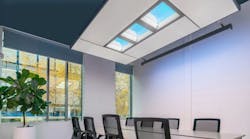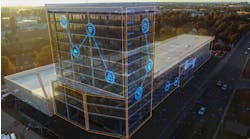From laboratories and academia to government and the private sector, light continues to lure the inquisitive. Research that sparked the solid-state lighting revolution is now moving on, seeking to uncover new qualities in light that can lead to greater understanding of how it can be better produced, deployed, controlled, and used. That was evident from presentations at the visionary Strategies in Light 2020 conference held in February, aptly headlined, “Discover the Opportunities of Light.” Assessing the current state of the lighting industry, speakers spanning multiple industry sectors played off the theme that what’s driven so much lighting innovation and growth — the quest for energy efficiency — is receding and slowly being replaced with a focus on tapping deeper into lighting’s functionality and controllability.
One keynote speaker, Robert Karlicek, Jr., a professor at Rensselaer Polytechnic Institute and director of the school’s Center for Lighting Enabled Systems & Applications (LESA), discussed emerging frontiers for solid-state lighting (SSL) now that most of the energy efficiency has been wrung out of LED. They include light as a data transmission medium; dynamic lighting controls; and micro-LED displays fusing video and illumination functionality.
He was echoed by another, Jim Benya, with Benya Burnett Consultancy, who said a broad lighting industry consensus formed some 30 years ago to deliver more efficient lighting has played out spectacularly but now must be succeeded by a push to set new and different performance targets that take advantage of the research community’s expanding understanding of light. To that point, keynoter Lawrence Lin, CEO of German lighting supplier LEDvance, reiterated one of the most promising value-added opportunities in lighting: advances in spectrally tuned solid-state lighting that can be leveraged in human-centric lighting (HCL) applications.
What’s next, it seems, is a push to make tomorrow’s lighting work harder and be more pliant, employing the full spectrum of light’s qualities and capabilities, literally and figuratively. Even with solid-state technologies now firmly entrenched, today’s lighting frontier remains seemingly wide open, spanning the readily attainable, the hard-to-imagine, and everything in between. More than a few next-generation technologies and potential applications, though, are truly intriguing, some of which hold promise for putting the industry on the scent of lighting’s next big thing.
Exploring biometrics
One trend that might bear watching is the possible marriage of biometrics and lighting. The expanding ability to measure human biological markers, states, and responses to stimuli could be useful in the quest for higher quality lighting and more responsive lighting control systems. Alongside growing knowledge of how the human body responds to light on multiple biological levels, that capability is driving more research into how lighting delivery could be fine-tuned on increasingly granular levels.
At the University of Southern California, Los Angeles, researchers at the Human-Building Integration Lab are investigating the feasibility of a lighting control system that responds to changes in eye pupil size, primarily a function of light levels entering the eye. That would be measured via a pupil-size sensor embedded in a wearable device or fixed camera in a space, and that data would then be transmitted to a lighting control system programmed to adjust light levels accordingly. The research is working off the idea that pupil size is a reliable and accurate indicator of optimal light and that controlling light based on that variable can yield multiple benefits.
“Ultimately, we see benefits in energy efficiency and comfort; improved health outcomes; and increased productivity in office environments and, perhaps, in educational settings,” writes Joon Ho-Choi, a professor of building science coordinating the research, in a recent posting on the West Coast Lighting Insider blog.
Lights that would adjust automatically and dynamically, based solely on biometric readings and without any other direct or indirect input or intervention, would perhaps represent the penultimate achievement in occupant-driven lighting control technology. While there is variability in pupil size and shape across human populations, researchers believe there is enough measurable uniformity in physiological response to light that controls utilizing that information are practical. One of the challenges, however, will lie in determining what levels and types of light correspond to pupil size — and how those can be optimized for the best occupant experience.
The team’s research is now focused on developing a prototype of a wearable device that would transmit biometric data to a control module that would learn patterns in pupil size changes as ambient light changes. Over the next year, the team will begin exploring how such a system could overcome the challenges of integration into a real-world environment.
“The burgeoning fields of lighting automation, artificial intelligence (AI), and biosensors may all have a role in the next generation of lighting controls that create a responsive environment to enhance comfort, productivity, and well-being,” Joon wrote.
A mock-up of Signify’s new human-centric lighting entry, NatureConnect, which simulates shifting natural light in varying color mixtures via an artificial skylight and lightbar luminaires that project onto walls. Courtesy of Signify
Automated controls
Another new detect approach to lighting controls — one that uses light to render advanced real-time occupant and space utilization-sensing technologies — is being pursued at Rensselaer. There, the LESA Center recently secured $2.8 million from the U.S. Department of Energy (DOE) to develop an occupant-centric control system that can detect activity in a space by using sensors that perceive shifts in its ambient light distribution, which is a function of how the space is configured and occupied. Changes to a space’s “optical fingerprint” indicate activity and usage, which can be dissected to reveal its utilization status at any given time and, in turn, its lighting needs, which would be handled by an autonomous lighting controls system.
The system LESA will develop over a three-year period with help from lighting solutions company Lumileds, LLC, San Jose, Calif.; Rensselaer’s Center for Architecture Science and Ecology; and architectural design firm, HKS, Inc., Dallas, has its foundation in a specific type of “time-of-flight” sensor technology developed and patented several years ago by LESA and Boston University. The sensors essentially map a space and deliver (using reflected light distribution data calculated on variables as granular as furnishing, wall, and occupant-clothing colors) constant updates on the presence, location, and spatial distribution of people and objects within it. With that real-time occupancy and utilization information, LESA says a lighting control system can be programmed to deliver the exact quantity, distribution, and even type and composition of light required. If that proves achievable, lighting utilization and energy costs could be better controlled, control systems could be more widely and routinely relied upon, and artificial light would be far more user-friendly.
“The question we’ll be trying to answer is can we design a fully automated lighting control system that optimizes lighting based on what a space looks like,” says Karlicek. “We’re talking about dynamic light sculpting, dimming it when no one is in the space, upping it when someone comes in, feeding spatial modeling information back to beam-steerable lights that can address (human health-related) circadian factors as well.”
The lighting itself will be an equally important element of the project. Lumileds will work to develop a new class of digitally programmable, dynamically sculptable LED luminaires that can respond to sensor data and dynamically change the spectral content and direction of emitted light. HKS will have a complementary role focused on developing room designs that perfect and optimize light distribution and building interior design-related data and lighting specifications that will be used in modeling and testing solutions.
“We’re interested in seeing if we can do all of what we need lighting to do with one fixture design, maybe a mini LED array that utilizes micro optics and custom lenses to steer narrow beam light versus traditional troffers and pan and tilt lighting,” Karlicek says.
A successful investigation of the concept, he says, would yield a major and timely advancement in both lighting and controls. With a growing focus on delivering light of a wavelength composition that’s safer and perhaps even health-promoting for people, an easily controlled spectrally tunable lighting solution could be in high demand. Perhaps more important is control functionality that can be fully independent of human input and reliant on a data collection method that preserves privacy.
“This concept stays away from the use of cameras, giving us the ability to know where people are but not who they are,” he says. “The issue of privacy versus getting the information needed in ‘smart’ technology systems is going to be a major battleground.”
Meanwhile, from a utilization standpoint, Karlicek sees major leaps forward in more fully autonomous controls as the best way to increase broader adoption and routine, uninterrupted usage of such systems.
“So many systems end up being decommissioned within a few years of installation because when they require some intervention, people don’t want to program them,” he says. “If they’re not simple to use, they won’t be used.”
LESA’s proposal for the project drew DOE’s interest, Karlicek says, because it addresses two key elements of its ongoing interest in advancing solid-state lighting: energy efficiency and occupant-centric controls. A system that reliably puts light where and when it is needed, in the right quantity, could reduce lighting-linked energy consumption up to 50%, Karlicek says, achieving a long-standing primary goal of LESA’s as well.
“In many ways, this project is the culmination of everything our center has been working on for many years,” he says. “We feel that if this proves out, someone will want to commercialize it.”
Occupancy sensors keying on light distribution within a space are central to lighting controls research underway at Cornell University’s Lighting Enabled Systems & Applications center. Real-time pose detection capability, illustrated here, could automatically control multiple room lighting variables. Photo courtesy of Cornell University
The HCL quest
That would follow the script of turning greater understanding of the complexities of how the human body processes and uses light into exploration and even development of new HCL lighting products and systems. It’s now understood through years of research, for example, that light has an array of non-visible components that affect biological processes such as circadian rhythms that trigger the need for sleep, the level of alertness, and even mood changes, depending on its composition, intensity, duration, and timing of exposure.
That line of exploration has continued to intensify, producing fresh insights into how so-called “tunable” circadian lighting can be refined, defined, and ultimately incorporated into value-added lighting solutions. Robert Steele, co-chair of the annual lighting conference Strategies in Light, says opportunities in designing HCL focused on promoting human health and well-being are still being assessed.
“It was only about 10 years ago that scientists discovered photoreceptors in the retina of the eye (that are key to the biological processing of light),” he says. “That kicked all of this off, and we’re now seeing more full-spectrum lighting designed to look more like natural sunlight, light that’s more pleasing and that comes with claims about circadian benefits. But there’s still a lot of science that needs to be done to measure the real benefits. The proof of some of this, though, is still elusive.”
A lack of clarity and agreement on what constitutes effective health-promoting lighting has contributed to hesitancy among product developers and called into question the efficacy of those that have been developed. However, a possible milepost in clearing up confusion came in May when Underwriters Laboratories published design guidelines for circadian lighting. The guidelines constitute an optional baseline performance goal for indoor lighting specifiers to consider when incorporating circadian features into illumination products and could thus help ensure sellers and buyers are on the same page.
Meanwhile, product development in that space continues. Technology leader Samsung is a recent entrant, announcing in March that it now has modules that lighting manufacturers can use to make products targeting production of the sleep-wake hormone melatonin. One module is designed to suppress melatonin production, making it ideal for day exposure when more alertness is desired. The other delivers less light in the spectrum’s blue range, increasing melatonin when sleep or relaxation is needed at night. Modules can be incorporated together in a single lighting product or separately, depending on the application.
A test-bed for Cornell University’s Lighting Enabled Systems & Applications center incorporates tunable ceiling lighting and pose-detecting light distribution sensors. Photo courtesy of Cornell University
Laser focus
Deeper understanding of light’s powers and methods of harnessing it is also rapidly elevating broader commercial prospects for a light source long pigeonholed as highly specialized and application-limited: optically amplified laser light, which was first patented 60 years ago. Now, expanded research efforts and a technology-driven market opportunity might be ready to bear fruit and open new doors for safely delivered laser light. A leader in laser light exploration is SLD Laser, Santa Barbara, Calif. The company, whose founders pioneered solid-state lighting, is researching opportunities for lasers in a range of diverse applications.
One is in the emerging market for faster, more secure wireless communications using LiFi (light fidelity), a nascent technology and possible rival or eventual successor to radio-spectrum enabled WiFi communication. The company says it has developed technology that can use laser light to transmit data at rate of more than 20 gigabits per second, which is 20 times faster than 5G and faster than LiFi technology that uses LED light. Laser LiFi’s powerful features, it says, could be employed in smart car and smart city applications where long-range data broadcast capability is needed, and in 10G fixed installations for offices, homes, and factories.
LiFi is becoming commercially available, but adoption thus far has been slow, meaning perhaps that laser LiFi could have a chance to leapfrog LED LiFi, assuming its movement through the current development phase accelerates without hitches. Another possible application for laser light could be illumination. SLD has been refining technologies to harness the powerful light source so it can be safely and controllably delivered, and it has made recent strides in fashioning product applications where demand might begin to grow for proven products. In 2019, it unveiled a laser spotlight technology dubbed SkyBeam that can deliver up to 12,000 lumens over five kilometers, potentially useful in applications ranging from entertainment and sporting events to architecture and ports. It also demonstrated a fiber-optic cable module capable of delivering light from a laser source to pendant, accent, and pole illumination fixtures. Fiber cabling, the company says, could be a method for making laser light practical in a range of applications by essentially creating fiber-optic plug-and-play laser lighting systems.
Given the steep technical and marketplace challenges required to make this a reality, that’s a scenario that could demand some suspension of disbelief; laser light applications would likely have to demonstrate cost-effective efficiencies or qualities far in excess of prevailing technology to be viable.
Similar hurdles surely await other efforts now underway to imagine better ways to deliver, control, and experience light. But the lure of digging deeper into light’s mysteries and asking the “what if” question has consistently paid dividends — from sparking the solid-state revolution to creating human-centric lighting to adapting ultra-violet light to the control of pathogens. That spirt of discovery is alive and well — and, if history is any guide, a payoff awaits the inquisitive, the bold, and the patient.
Zind is a freelance writer based in Lees Summit, Mo. He can be reached at [email protected].


